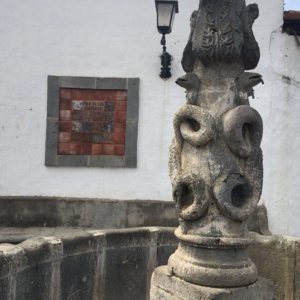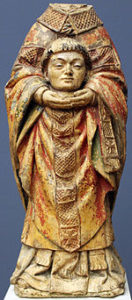Podcast: Play in new window | Download
Subscribe: Apple Podcasts | RSS
The state of Jalisco in west-central Mexico is home to many legends. Here are 5.
The Healer who Became a Goddess
In the times before the Spanish arrived in Mexico, in the town of Tlayolan on the shores of Lake Zapotlán, there lived a very beautiful woman. This lady was reputed to be an excellent healer, capable of curing any disease, even the lethal ones. The incredible woman was named Tzapotlatena.
The beautiful healer was the granddaughter of a lady very respected by the community, and one of its oldest. This was another reason why the healer was also very respected and loved. First and foremost, though, she was very admired for her healing gifts that were extraordinary. She also had a vast knowledge of the medicinal plants of the region and was a woman known to be most virtuous and modest.
 On day, Tzapotlatena was in the field studying the plants and collecting some that he needed for her box of medicines, which she always kept well stocked. While gathering the herbs she saw a child approaching her running and screaming. When the child was next to the healer, she told her that her mother was in labor, but that the situation was very delicate since the baby could not get out of her mother’s womb.
On day, Tzapotlatena was in the field studying the plants and collecting some that he needed for her box of medicines, which she always kept well stocked. While gathering the herbs she saw a child approaching her running and screaming. When the child was next to the healer, she told her that her mother was in labor, but that the situation was very delicate since the baby could not get out of her mother’s womb.
Tzapotlatena ran to the house of the woman in labor to help her. However, delivery was very difficult and anything the healer tried did not have any positive effect. Tzapotlatena, in her desperation to help the woman, asked some men who were outside the home watching what was happening, to bring a lot of resin from the pines, as much as they could. The men left hurriedly to fulfill the requests of the healer. When they returned to the hut, Tzapotlatena quickly made plasters that she placed in the belly of the expectant mother, who was insane with pain.
After a while, the plasters worked, and the poor woman’s pain subsided. A strong and healthy child was born. The beautiful healer was impressed by the powers of resin plasters. She never imagined that they would have been so effective. From then on, when she assisted a woman in labor, she used resin plasters to help with the pain and to facilitate difficult delivery. The wonderful pine resin plasters not only served to help women in labor but could cure other diseases.
Years later, Tzapotlatena was bitten by a very poisonous snake and became very gravely ill. Local healers applied her famous plasters of resin, but the woman did not react and every time she got worse. As the days passed, the healer became thinner and the color left her face. In the end, Tzopotlatena died. She who had cured so many people had not been able to heal herself. Her funeral was very beautiful and crowded. All the communities in the area came with white flowers as a tribute to a woman so kind and wise. She became a goddess to whom the sick prayed and asked for miracles.
In addition, the healers converted her into their deity, whom they revered for their discovery of savior resin plasters. As always, she cured the one who worshiped her. She soon became famous not only in Jalisco, but even in the Señorío de Michoacán and the Kingdom of Cazcan. The town of Tlayolan where the beautiful goddess was born, became Tlayolan-Tzapotlan, the place where she was venerated and dedicated as the Goddess of the Healers.
The Ghostly Nun
 Many years ago in the city of Guadalajara, capital of the Mexican state of Jalisco, there lived a young girl named Fermina. One day Fermina was taken by her mother to the Civil Hospital due to a severe pain in her belly. When she arrived at the hospital, they had to operate on her urgently. The doctors quickly anesthetized her and took her to the operating room to proceed. Fermina fell asleep under the effects of anesthesia.
Many years ago in the city of Guadalajara, capital of the Mexican state of Jalisco, there lived a young girl named Fermina. One day Fermina was taken by her mother to the Civil Hospital due to a severe pain in her belly. When she arrived at the hospital, they had to operate on her urgently. The doctors quickly anesthetized her and took her to the operating room to proceed. Fermina fell asleep under the effects of anesthesia.
When he awoke, she was in a tall white room, with many beds full of complaining patients. The darkness of the enclosure was only attenuated by a light that came from the cubicle of the sick women. Fermina realized that a woman dressed in the habits of an ancient nun was walking among the beds of the sick. With her face covered, the nun would stop at each bed, look at the mourner and pray. The apparition was repeated every night, just as the nurses turned off the light and moved to their cubicle.
One day, Fermina asked one of the nurses about the identity of that nun, but the nurse refused to answer her. That night, Fermina decided she wanted to go take a bath. As she approached the bathroom, she heard that someone was taking a shower. Cautiously, Fermina began to spy and saw that a woman with long black hair was under the shower, but instead of running water what ran across her body and onto the floor was blood! Suddenly, the woman turned and stared at Fermina with very black eyes. Frightened, the young woman returned to the bedroom trembling with horror.
Shortly after that incident, Fermina became friends with a patient her age. The girl asked Fermina if she had seen a nun who walked between the beds of patients. Fermina replied: “Of course I see her. She always comes to pray to the sick to be cured quickly.” Then the friend replied: “But you have not understood me. That woman is dead! Look closely, her face is a skull and it floats because it has no feet!”
Not believing what her friend said, Fermina decided to see for herself. At night she waited for the nurses to turn off the lights and she lay in wait. A short time later the nun appeared. Fermina pretended to sleep, but he watched her sneakily half covered by the sheets on her bed. When the nun approached her bed, she could see that, indeed, the nun floated, and her face was a horrible skull with two deep black holes like eyes. In the face of such a terrible apparition, Fermina fell in a faint.
The next day, very early, the girl, despite not yet being discharged, took her suitcase from under the bed, dressed in haste, and ran fast to her humble home, vowing that she never again would set foot on the grounds of that chilling Civil Hospital where the ghost of a nun appeared.
The Four Marys
 Tapalpa is a very old town, dating from the pre-Hispanic times, located in the state of Jalisco, in the Lakes Region. Its name means in Otomi, “Land of Color”. At the end of the 19th century, four women with the first name of Mary lived in Tapalpa. Specifically, they were: Maria Amaranta, Maria Natalia, Maria Eduviges and Maria Tomasa. The inhabitants of the town called them the Marías Lenguas; a nickname that they had earned themselves by being extremely gossipy and taking great joy in speaking ill of everyone they could. They did not lack subject matter. Their gossip had already caused severe damage to the reputations of many of the neighbors, which is why they were feared by all. It seems that the biggest gossip of all was María Tomasa, for having a very fruitful imagination that helped her to make gossip where there was none or to enrich and increase existing stories.
Tapalpa is a very old town, dating from the pre-Hispanic times, located in the state of Jalisco, in the Lakes Region. Its name means in Otomi, “Land of Color”. At the end of the 19th century, four women with the first name of Mary lived in Tapalpa. Specifically, they were: Maria Amaranta, Maria Natalia, Maria Eduviges and Maria Tomasa. The inhabitants of the town called them the Marías Lenguas; a nickname that they had earned themselves by being extremely gossipy and taking great joy in speaking ill of everyone they could. They did not lack subject matter. Their gossip had already caused severe damage to the reputations of many of the neighbors, which is why they were feared by all. It seems that the biggest gossip of all was María Tomasa, for having a very fruitful imagination that helped her to make gossip where there was none or to enrich and increase existing stories.
To carry out their gossip they used to meet by a fountain that was near their houses, and that was called La Pila. One day the comadres were very comfortable talking about people badly, when an Otomi Indian approached the fountain. Macario was very old and had always devoted himself to witchcraft, a job he had inherited which went back for generations from very ancient times.
Upon hearing the gossip they were bringing, Macario went to the Marías Lenguas and told them very seriously that, if they did not stop saying silly things and inventing gossip about people, it would go very wrong and they would have to pay the consequences that their talkative acts would bring them.
The Marias, hearing the Indian warlock speak, began to laugh at him and insult him very aggressively. Before the insults, Macario answered them very calmly that they were warned and that, if they continued with their gossip, the punishment that they would receive would be tremendous. As the gossips continued making fun of the Indian, he took water from the fountain, and saying some magic words, he threw the water at the four women.
Feeling the water bewitched over their bodies, the women had an attack and contorted themselves rolling on the floor. Little by little, they became snakes. Macario then addressed them and said: “For being such bad people and gossips, I condemn them to become forever stone snakes, to serve as an example to people who enjoy ruining the people with their fateful gossip!”
And so it was, the stone snakes climbed the fountain and each took a place where they would be forever. Since then the fountain is known as the Snake Stack.
The Fatal Concoction
In the year of 1708, lived in Santa Maria de los Lagos, Jalisco, a beautiful young woman called Francisca de Orozco. Her father had been a rich Spaniard and her mother a poor Indian of the region. Every day she went to the Temple of the Assumption to hear mass, because she was deeply religious.
On one occasion when she was standing in the atrium of the church, a Spanish woman named Juana de Isasi, rich and of noble birth, stopped in front of her and loudly began to insult Francisca, accusing her of having murdered one of her maids by means of sorcery.
 From that moment Francisca hated with all her soul the woman named Juana de Isasi, and wished to take revenge on her accusations as soon as possible. Indeed, the young woman knew a lot about witchcraft thanks to her mother who had taught her the dark arts when she was a child.
From that moment Francisca hated with all her soul the woman named Juana de Isasi, and wished to take revenge on her accusations as soon as possible. Indeed, the young woman knew a lot about witchcraft thanks to her mother who had taught her the dark arts when she was a child.
One day, when she was in her humble home, Francisca began to prepare a substance with the herb called ololiuhqui, which was also given the names of Sacred Plant and Grass of the Snake. It is noteworthy that the plant was forbidden by the Holy Inquisition, since it was considered a demonic plant, for its terrible hallucinogenic effects.
Francisca was very careful in the preparation of the potions that she prepared with the herb. When she finished making the fatal brew, Francisca gave some of it to Mariana la Negra, her African friend who worked as a slave in the house of Juana de Isasi. Mariana was the one in charge of bringing the food to her mistress, and since the older Spanish lady treated her the worst, Mariana la Negra also hated her as much as her friend Francisca did.
At lunchtime, Mariana put part of the concoction in her mistress’s milk dessert. She liked it a lot and even asked for seconds. Immediately, the Spanish lady foamed at mouth, her face filled with blood and she ran desperately through the house while yelling: “Francisca, Francisca Orozco!”
While this was happening, the young Francisca used one of her mother’s spells to turn herself into an owl. In her new form as a bird she watched the Spaniard from the garden of her house. At one point, Francisca-as-an-owl took the lifeless body of the unhappy and evil woman in her clutches and left her pair of blue eyes hanging on a branch.
Francisca had fulfilled her revenge and felt satisfied. However, the next day the officials of the Holy Inquisition arrived at Francisca’s small house and took her away. After torturing her for several days, the girl was burned at a bonfire in the plaza of the small town of Santa María de los Lagos.
The Headless Priest
Long ago in Tonalá there lived a Franciscan priest who led an exemplary life dedicated to serving God. He was very well loved, respected by the faithful and every person who knew him; but not everything was perfect, because he also had enemies who envied him and went to the office of the Inquisition claiming he had a pact with the devil.
One night the father was having dinner peacefully in his private quarters, and he was taken away without explanation and brought to one of the prisons of the Inquisition. Since the ecclesiastical authorities did not have proof to blame him, they decided to extract a confession out of him by applying the torture of cord treatment. In this torture method, the victim has ropes tied around his wrists and is hoisted several feet above the floor and left to dangle.
 In this case, the poor father, after they hoisted him five feet up, they dropped him and lifted him from a pole with terrible pains. The father confessed again and again his innocence. The inquisitors did not believe the priest, so they put weights on his feet so that the pain was more intense, but still the religious man proclaimed his innocence.
In this case, the poor father, after they hoisted him five feet up, they dropped him and lifted him from a pole with terrible pains. The father confessed again and again his innocence. The inquisitors did not believe the priest, so they put weights on his feet so that the pain was more intense, but still the religious man proclaimed his innocence.
After prolonged and painful torture, the father pleaded guilty to all charges, then he was tried and convicted.
He was dressed in a pointed cap called a capirote and a yellow wool cloak, which was stamped with a cross of San Andrés, surrounded by rows of benches from which people hurled vile insults and threw things at him. The religious people of Tonalá who loved the priest very much locked themselves in their houses so as not to see the humiliation unleashed on the innocent victim.
After the procession, the father was hanged and beheaded.
People who live in the town to this day say that those who pass by the tree where they are hanged see a priest without a head officiating a Latin Mass. Also, at midnight in the vicinity of the Parish of Santiago Apóstol, on the route that is located between the arch and the bell tower, those who pass by, still can see the silhouette of the headless priest.
REFERENCES
Much appreciation given to the Leyendas de Mexico web site.
